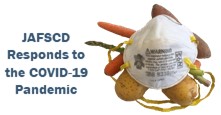Case study of a food relief grocery model: The Neighborhood Pop-Up Grocery Project
DOI:
https://doi.org/10.5304/jafscd.2021.102.012
Keywords:
Food Relief, Local Food Movement, COVID-19, Pandemic, Food DistributionAbstract
In Austin, Texas, Sustainable Food Center, in partnership with Foodshed Investors and the city of Austin, responded to the COVID-19 crisis with a mini-grocery pilot project. The Neighborhood Pop-Up Grocery Pilot Project engaged local restaurants to serve as points of access for fresh and affordable food. This model served as both a food-access and supply-chain solution, utilizing partnerships with local farmers and distributors to source food for Austin communities and restaurant partners in order to provide the food at an affordable price point. This case study outlines the novel model and describes three key takeaways from this 2020 pilot project.
Metrics

Downloads
Published
How to Cite
Issue
Section
Categories
License
The copyright to all content published in JAFSCD belongs to the author(s). It is licensed as CC BY 4.0. This license determines how you may reprint, copy, distribute, or otherwise share JAFSCD content.













